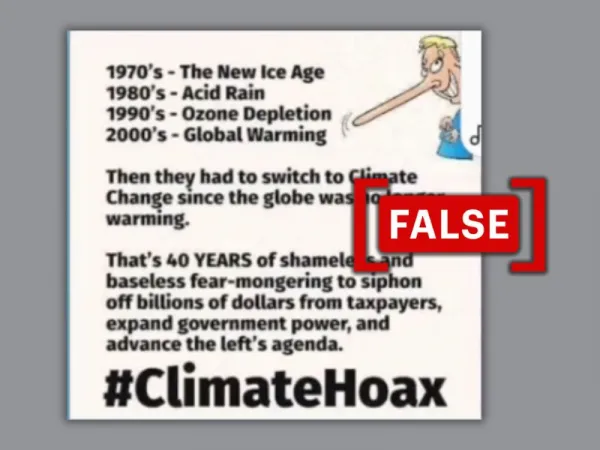By: Rahul Adhikari
June 25 2024
 A social media post claims enviornmental issues like acid rain, global warming and climate change are fake. (Source: Instagram/Modified by Logically Facts)
A social media post claims enviornmental issues like acid rain, global warming and climate change are fake. (Source: Instagram/Modified by Logically Facts)
There is enough scientific evidence to conclude that environment-related issues like acid rain, ozone depletion, and global warming are not hoaxes.
What is the claim?
A post circulating on social media claims that events and topics like the new ice age, acid rain, ozone depletion, and global warming are hoaxes and actually "shameless and baseless fear-mongering to siphon off billions of dollars from taxpayers, expand government power, and advance the left's agenda."
The text in the image included in the post read, "1970's - The New Ice Age, 1980's - Acid Rain, 1990's - Ozone Depletion, 2000's - Global Warming. Then they had to switch to Climate Change since the globe was no longer warming. That's 40 YEARS of shameless and baseless fear-mongering to siphon off billions of dollars from taxpayers, expand government power, and advance the left's agenda. #ClimateHoax." An archived version of the post can be accessed here.
A screenshot of the post circulating on social media. (Source: Instagram/Modified by Logically Facts)
However, the claim is false. We found that scientific knowledge and data prove that acid rain, ozone depletion, and global warming are real and that any claims of a scientific consensus on global cooling or an impending ice age are a myth.
How did we find the truth?
We investigated the viral post's reference to various events and topics to determine their scientific veracity.
Acid rain
According to the United States Environmental Protection Agency (EPA), "Acid rain, or acid deposition, is a broad term that includes any form of precipitation with acidic components, such as sulfuric or nitric acid that fall to the ground from the atmosphere in wet or dry forms."
Acid rain was a major environmental concern in Europe and North America during the 1970s and 1980s. While it still occurs, its impact has greatly diminished in these regions because of strict air pollution regulations.
Ozone depletion
National Geographic defines the ozone layer as "a thin part of Earth's atmosphere that absorbs almost all of the sun's harmful ultraviolet light."
In the 1970s, scientists discovered that human-made chlorine and bromine chemicals were depleting the stratospheric ozone. By the 1980s, it became clear that these chemicals or ozone-depleting substances (ODS) had created a worsening "ozone hole" over Antarctica each spring. In response, the Montreal Protocol was signed in 1987, aiming to phase out ODS completely, leading to a significant decrease over the next few years. The ozone layer is expected to almost recover to its pre-1980 levels by the mid-21st century.
Ice age
It is scientifically well-documented now that, in the 1970s, a myth was circulating about a scientific consensus about the so-called "impending ice age." The American Meteorological Society's September 2008 report "The Myth of the 1970s Global Cooling Scientific Consensus" clearly debunks the idea of a consensus on global cooling or an impending ice age in the 1970s. It attributes this misconception to a misinterpretation of scientific literature that actually focused on greenhouse warming.
NASA has also clarified that there is no impending ice age or mini-ice age, and the Sun periodically enters phases of reduced activity known as "Grand Solar Minimums," leading to a temporary cooling of the Earth by up to 0.3 degrees Celsius.
Global warming
Organizations like NASA have confirmed that global warming is the unusually rapid increase in Earth's average surface temperature over the past century, primarily due to greenhouse gases released by burning fossil fuels. Earth was about 2.45 degrees Fahrenheit (or about 1.36 degrees Celsius) warmer in 2023 than in the late 19th century (1850-1900) preindustrial average. The 10 most recent years are the warmest on record.
According to Copernicus Climate Change Service (C3S), 2023 was the warmest year in history. It was 0.60 degrees Celsius warmer than the 1991-2020 average and 1.48 degrees Celsius warmer than the 1850-1900 preindustrial level.
Climate change
Climate change refers to significant and long-term changes in the Earth's climate, primarily due to human activities such as burning fossil fuels, deforestation, and industrial processes that release greenhouse gases into the atmosphere.
NASA and the United States Environmental Protection Agency (EPA) have pointed to human activities as the primary driver of global warming since the mid-20th century. Peter Jacobs, a climate scientist at NASA's Goddard Space Flight Center's Office of Communication, had earlier told Logically Facts, "Human activities, principally our carbon dioxide emissions, have been responsible for the observed warming since preindustrial times."
The verdict
The claim that acid rain, ozone depletion, global warming, and climate change are all hoaxes is clearly false, as evident from the comprehensive scientific evidence and consensus about them. While it is true that the "New Ice Age" was a myth, the claim seems to imply that there was a scientific consensus about it, which is untrue. Therefore, we have marked this claim as false.